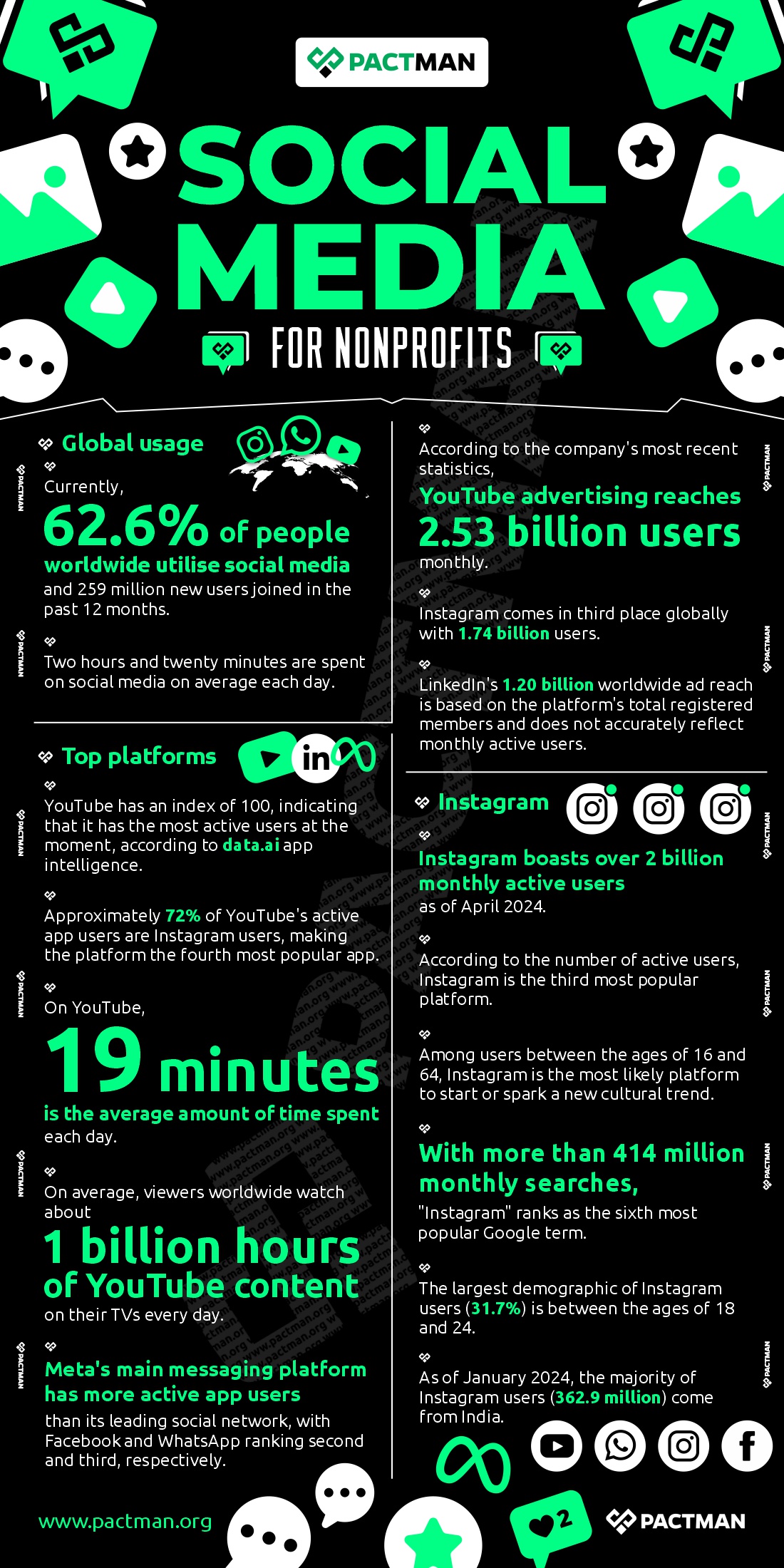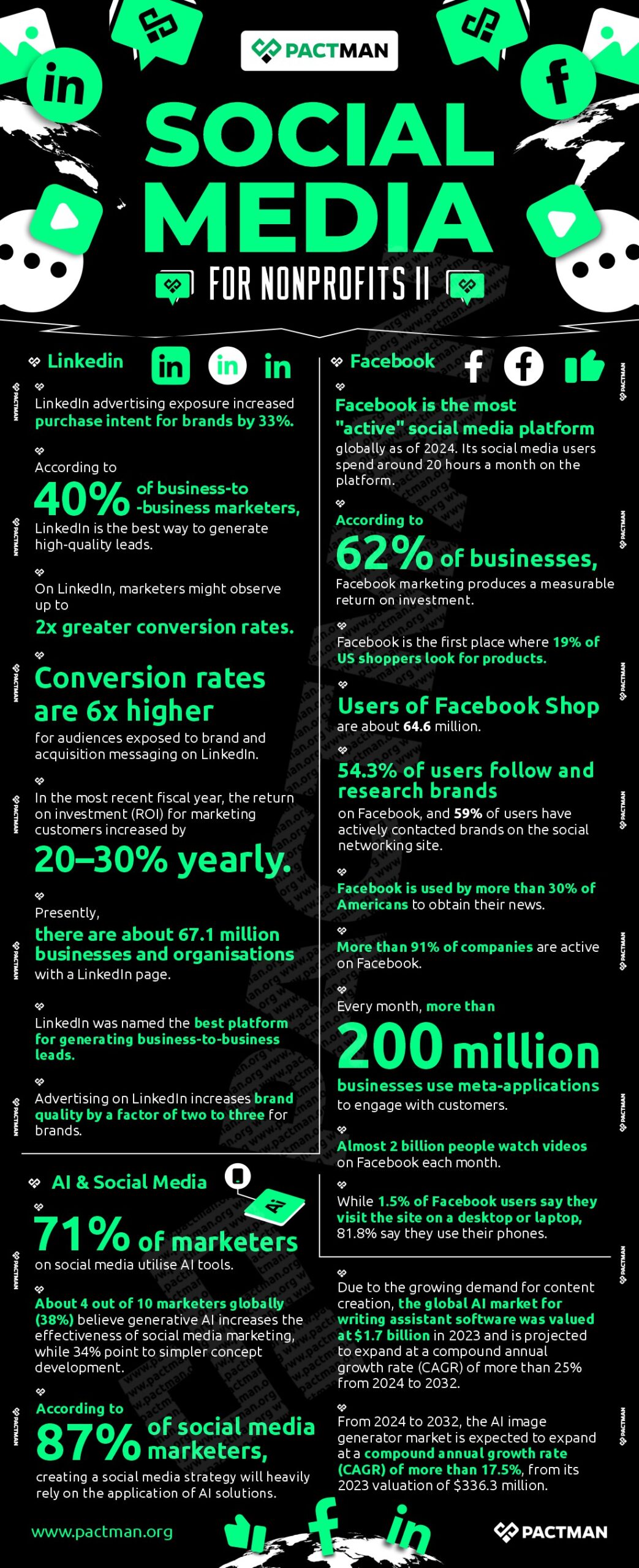I
Introduction
The emergence of social media platforms such as Facebook and Twitter has sparked a revolution in public relations and the internet. This has created an instantly accessible online community. Compared to websites backed by organisations, the communication capabilities offered by these more recent applications are very different and diverse.

As we all know, communities of online subscribers exist on all social media platforms. As a result, organisations frequently overcome boundaries related to geography, demographics, language, and culture. Consequently, a change like this offers practitioners who are well-versed in social media a plethora of opportunities.
The phrase “social media” refers to a broad range of online resources, most of which fall under one of many categories. This includes blogs, social networking sites, virtual social worlds, content communities, collaborative projects, and virtual gaming worlds. For the most part, nonprofit organisations use this medium to graphically represent their missions. In particular, nonprofit organisations connect people based on their social passions through social sites.
This article will consider how nonprofits can effectively leverage social media to enhance visibility and fundraising.
III
Understanding the Impact of Social Media
Social media has completely changed how businesses and marketers operate today by giving all organisations access to a large audience of possible stakeholders. Hence, by successfully connecting to target audiences through the power of virtual social networking, nonprofits that learn to use these platforms effectively could gain from practically every organisational endeavour, including marketing, fundraising, and advocacy.

Beyond what was feasible with email or websites, the emergence of more recent communication technologies like blogs, instant messaging, and Internet Relay Chat signalled a qualitative shift in the possibility of communication. This section will outline the wide impact of social media and the opportunities prevalent for nonprofits.
a. Audience reach
Firstly, social media channels are among the most effective ways to spread information to people of all ages. Essentially, this is through advertising and one-on-one interactions, although user demographics differ depending on the social media platform. Despite its beginnings as a collegiate networking site, Facebook has grown into a social media behemoth with over 900 million users from a wide range of backgrounds, ages, and cultures.
b. Marketing strategy
Secondly, social media is primarily used for marketing in both the public and private sectors to boost interaction, brand awareness, and loyalty. All in all, these goals are especially crucial for nonprofits since their success depends on the support and donations of others.
As can be seen, social media companies have developed nonprofit-specific websites in response to this philanthropic need such as Google for Nonprofits.
Also, the marketing interaction between nonprofit and for-profit organisations has been examined by analysts. Through this promotional cooperation, both organisations stand to gain. While nonprofits will gain more publicity and financing for their cause, for-profits will see a rise in social value and brand awareness.
c. Earned Income Strategies
In contrast to contributed funds, earned income is the payment for goods or services that the organisation has rendered [via various commercial endeavours]. Oftentimes, nonprofits rely on this kind of income to stay afloat.
d. Support system
In recent years, social media has been used by numerous NGOs that specialise in emergency relief operations to mobilise assistance after disasters. In response to the 2010 Haiti earthquake, numerous charitable organisations were successful in recruiting volunteers and funds via social media sites like Facebook and Twitter. These historical instances demonstrate how even seemingly insignificant social media blunders can result in significant change.
e. Nonfinancial benefits
Also, nonprofits can gain several non-monetary advantages from the strategic use of social media platforms. This includes greater web presence, access to a worldwide audience, improved management and professional productivity, and the availability of ongoing feedback channels.
Even more, most of the non-monetary advantages revolve around social media’s most basic feature, which is instantaneous worldwide communication. These platforms enable the rapid and wide-scale distribution of information. Enhanced productivity is made possible by the fact that information or messages may be rapidly shared, enabling more effective collaboration.
All in all, social networking platforms offer ongoing feedback channels. With a multidirectional information flow to create and track discussions that are relevant to nonprofits, feedback channels make it easier to build new connections and strengthen current ones.
f. Financial benefits
Lastly, some of the financial advantages of social media are utilisation costs, time savings, fundraising opportunities, and support visibility. Compared to more conventional forms of media like print, billboards, radio, and television, their use is reasonably priced. This makes it possible for nonprofits with infamously little funding to engage in marketing their activities and services to a younger, bigger, and newer audience of possible consumers and donors.
Also, the time-saving aspect of social media use offers an additional financial advantage. Faster marketing strategies require fewer employees and dedicated hours. Organisations can benefit from peer pressure, social proof, the social network effect, and impulsive donations by using social media applications for fund generation. Even more, crowd-funding tools can be used to grow revenue appealingly. Apps such as GoFundMe and Crowd Rise give organisations access to a large network of individual donors and provide a simple internet platform for making direct donations to charities and causes.
Additionally, in peer-to-peer fundraising, people can also act as solicitors for causes they endorse. Since donations account for the majority of nonprofits’ revenue, effective fundraising is crucial and made possible by these platforms.
All things considered, social media have created opportunities for communication, interaction, and interpersonal engagement that are qualitatively distinct from those provided by conventional websites. Therefore, it stands to reason that social media would also have a lot of potential as a tool for stakeholder interactions and corporate communication.
II
Critical Statistics on Social Media Use
This section will consider the impact of social media platforms globally and how organisations are leveraging these platforms.
1. Global usage
Currently, 62.6% of people worldwide utilise social media and 259 million new users joined in the past 12 months. Also, two hours and twenty minutes are spent on social media on average each day.

2. Top platforms
YouTube has an index of 100, indicating that it has the most active users at the moment, according to data.ai app intelligence. Approximately 72% of YouTube’s active app users are Instagram users, making the platform the fourth most popular app. On YouTube, 19 minutes is the average amount of time spent each day. On average, viewers worldwide watch about 1 billion hours of YouTube content on their TVs every day.
Furthermore, Meta’s main messaging platform has more active app users than its leading social network, with Facebook and WhatsApp ranking second and third, respectively.
According to the company’s most recent statistics, YouTube advertising reaches 2.53 billion users monthly. Instagram comes in third place globally with 1.74 billion users. It is crucial to note that LinkedIn’s 1.20 billion worldwide ad reach is based on the platform’s total registered members and does not accurately reflect monthly active users.
3. Instagram
Instagram boasts over 2 billion monthly active users as of April 2024. According to the number of active users, Instagram is the third most popular platform. Among users between the ages of 16 and 64, Instagram is the most likely platform to start or spark a new cultural trend.
With more than 414 million monthly searches, “Instagram” ranks as the sixth most popular Google term. The largest demographic of Instagram users (31.7%) is between the ages of 18 and 24. As of January 2024, the majority of Instagram users (362.9 million) come from India.

4. Linkedin
LinkedIn advertising exposure increased purchase intent for brands by 33%. According to 40% of business-to-business marketers, LinkedIn is the best way to generate high-quality leads. On LinkedIn, marketers might observe up to two times greater conversion rates.
Also, conversion rates are six times higher for audiences exposed to brand and acquisition messaging on LinkedIn. In the most recent fiscal year, the return on investment (ROI) for marketing customers increased by 20–30% year over year.
Presently, there are about 67.1 million businesses and organisations with a LinkedIn page. LinkedIn was named the best platform for generating business-to-business leads. Also, advertising on LinkedIn increases brand quality by a factor of two to three for brands.
5. Facebook
Facebook is the most “active” social media platform globally as of 2024. Its social media users spend around 20 hours a month on the platform. According to 62% of businesses, Facebook marketing produces a measurable return on investment. Furthermore, Facebook is the first place where 19% of US shoppers look for products. Users of Facebook Shop are about 64.6 million.
Also, 54.3% of users follow and research brands on Facebook, and 59% of users have actively contacted brands on the social networking site. Not to mention, Facebook is used by more than 30% of Americans to obtain their news. More than 91% of companies are active on Facebook.
Every month, more than 200 million businesses use meta-applications to engage with customers.
Watching videos takes up half of Facebook time. Almost 2 billion people watch videos on Facebook each month. While 1.5% of Facebook users say they visit the site on a desktop or laptop, 81.8% report that they use their phones.
6. AI Social Media
71% of marketers on social media utilise AI tools. About 4 out of 10 marketers globally (38%) believe generative AI increases the effectiveness of social media marketing, while 34% point to simpler concept development. According to 87% of social media marketers, creating a social media strategy will heavily rely on the application of AI solutions.
Due to the growing demand for content creation, the global AI market for writing assistant software was valued at $1.7 billion in 2023 and is projected to expand at a compound annual growth rate (CAGR) of more than 25% from 2024 to 2032. Also, from 2024 to 2032, the AI image generator market is expected to expand at a compound annual growth rate (CAGR) of more than 17.5%, from its 2023 valuation of $336.3 million.
IV
How Nonprofits Can Leverage Social Media
There is fierce competition and a lot of noise on social media. Hence, your organisation must learn how to attract people through content and messaging. In this section, we will consider some effective ways nonprofits can leverage social media for visibility and donations.

a. Develop a Strategy
For nonprofits to succeed, they must use social media in a methodical and organised way. As a result, you will need to examine your organisation’s internal capabilities and current capacities and leverage its strengths. The first step in your plan is to choose the social media team. Here, you will assess the experience and comfort levels of the personnel who will be participating.
Secondly, the strategy and objectives of the social media campaign should be communicated to all staff members. This is regardless of the size of the organisation and even if they are not directly in charge of carrying it out. Also, all participating employees must agree on the topic and main points of the content the organisation will be creating. You must assess your current social media presence, the desired future state, and the goals and objectives that will help your nonprofit get there.
Likewise, stress the value of establishing quantifiable goals and objectives to help with the strategy’s implementation and assessment. This will help with selecting a variety of suitable social media platforms to suit the requirements. Developing a well-defined strategy will help your nonprofit stay on track to achieve its objectives and maintain a consistent message.
Most people agree that the best strategies define the roles and responsibilities of team members. This also includes choosing a variety of media to spread messages that support the organisation’s mission. Consequently, organisations should map out their social networks and target audiences, and ensure that their social media initiatives align with their strategic plan and direction.
b. Foster Meaningful Relationships and Engagement
Secondly, nonprofits must place a strong emphasis on reciprocal communication to encourage the development of connections and involvement with both new and current networks. Also, nonprofits must do more than just supply information on social media; they also have to promptly address the queries, comments, and criticism from people in their online networks.
Now more than ever, organisations can play a significant role in online discussions that connect them to other groups, communities, and interest groups. This opportunity might not have been achievable through traditional media, marketing, and other channels. However, social network platforms prioritise multidirectional flows of communication and face-to-face networking.
By actively participating in online discussions, nonprofits can reach influencers and larger networks of stakeholders and constituencies, engaging prospective supporters of their causes in addition to increasing public awareness. Accordingly, nonprofits should routinely give their audience information, opportunities for participation, and statements of appreciation and value before requesting donations and promoting their work online.
When giving the public a chance to participate, nonprofits should remember to urge people to share their involvement with their networks. By publicly demonstrating their support, people establish social proof of legitimacy and necessity. This in turn makes it more likely that their connections will join in by making donations or exchanging information.
NPOs can better inform their social media strategy by actively and successfully establishing relationships with social media audiences. This will help them gain a broad understanding of how people and groups are related to issues across industries and disciplines.
c. Maintain a Constituent Centered Perspective
Thirdly, organisations must understand their target audience and tailor their content to appeal to their constituents and potential stakeholders. By and large, this helps to establish relationships and ensure effective audience engagement.
To begin with, map out your nonprofit social networks and determine the values of important audience segments. Note that your social media content needs to be tailored to the main demographics you serve.
d. Use Visual Communication for Storytelling
Furthermore, organisations must use their content to present an emotional story that captures the intersection of the organisation’s and the audience’s values. Generally, the subjects that the public finds most emotionally appealing are those that deal with health, emergencies, and show an urgent need that they can help address.
Visual aids like pictures and infographics, which may sometimes tell a story more quickly and efficiently than words, are especially useful in telling stories. In addition to providing visual attractiveness to your material, these tools can successfully grab viewers’ attention and entice them to be more open to textual content.
Most importantly, a significant portion of the narrative should focus on donors and how they have improved the public good. This will help viewers relate to and emulate the giving habits your nonprofits want to encourage. In addition, the social media campaign should aim to increase action reactions and donation behaviours, and as such, it needs to be tracked and evaluated. These behaviours are one of the most crucial traits of nonprofit organisations that effectively employ social media.
e. Evaluate Effectiveness and Make the Needed Adjustments
Lastly, the most successful and well-connected nonprofits keep an eye on the results of their social media campaigns, develop conclusions, and modify their strategies based on this data. Typically, data-driven NGOs with a strong network make constant adjustments to their social media strategies to increase their efficiency and improve their influence.
Also, nonprofits won’t be able to determine whether their social media strategy helps them achieve their goals and objectives if they don’t use assessment to establish a culture of learning. Evaluating the success of your strategies for improvement helps ensure social media platforms are leveraged to their maximum potential.
According to earlier research, assessing social media use is one of the most important but also one of the most difficult tasks for nonprofits. However, organisations can overcome this hurdle by offering audience-relevant content that will encourage people to share and repost. Also, be upbeat. Honour triumphs and accomplishments.
When utilised properly, social media may mobilise people and can also generate momentum and motivate action through community participation.
Conclusion
In summary, the proliferation of new media has greatly improved NGOs’ capacity to interact with volunteers, the public, regulators, and clients. Even more, nonprofits can inspire stakeholders, create deep connections, and eventually promote more accountability and public confidence by using high-quality and relevant content.
Due to the ever-evolving nature of the internet, new social media platforms and upgrades are frequently created. Furthermore, current social media platforms regularly update their offerings. For this reason, nonprofits must regularly study the latest social media trends and act accordingly.


